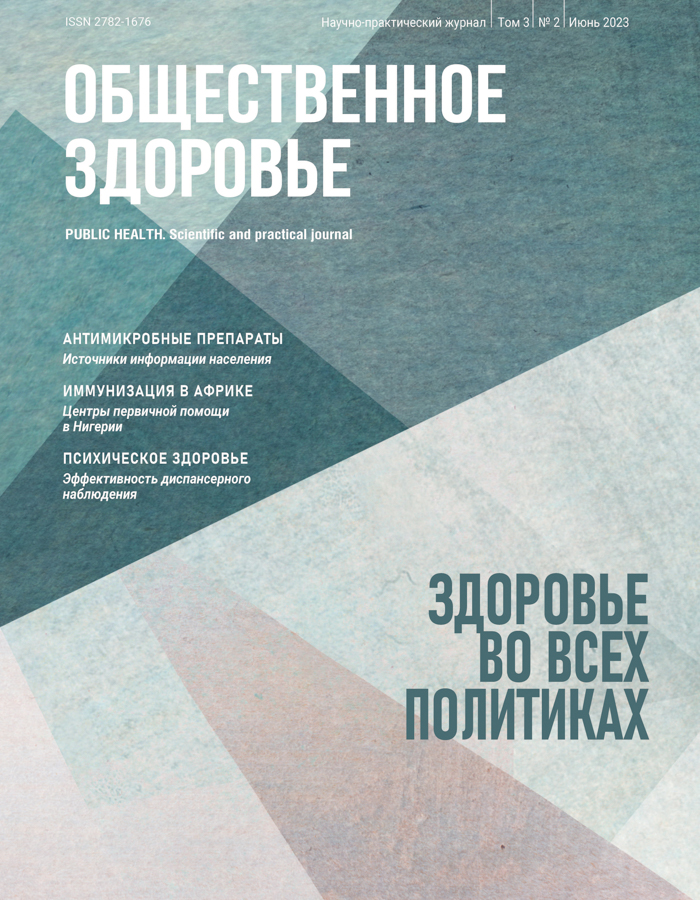Quality assessment of childhood immunisation services in primary health centres in Oron, Akwa Ibom State, Nigeria
- Authors: Esu D.J.1, Kicha D.I.1
-
Affiliations:
- Peoples’ Friendship University of Russia
- Issue: Vol 3, No 2 (2023)
- Pages: 21-30
- Section: INTERNATIONAL ASPECTS OF PUBLIC HEALTH
- URL: https://journals.rcsi.science/2782-1676/article/view/252911
- DOI: https://doi.org/10.21045/2782-1676-2023-3-2-21-30
- ID: 252911
Cite item
Full Text
Abstract
About the authors
David John Esu
Peoples’ Friendship University of Russia
Email: isu.rudn@bk.ru
ORCID iD: 0000-0002-8865-9605
D. I. Kicha
Peoples’ Friendship University of Russia
Email: kicha_di@pfur.ru
ORCID iD: 0000-0001-6529-372X
References
- Jamie Perin, Amy Mulick, Diana Yeung, Francisco Villavicencio, Gerard Lopez, Kathleen L. Strong, David Prieto-Merino, Simon Cousens, Robert E. Black, Li Liu, Global, regional and national causes of under-5 mortality in 2000–19: an updated systematic analysis with implications for the Sustainable Development Goals, The Lancet Child & Adolescent Health, Volume 6, Issue 2, 2022, Pages 106–115, ISSN 2352–4642, https://doi.org/10.1016/S2352–4642(21)00311-4.
- Dunavan C.P. Are We Truly Winning the War Against Malnutrition? Am J Trop Med Hyg. 2022 Mar 14;106(5):1561–4. doi: 10.4269/ajtmh.22–0006. Epub ahead of print. PMID: 35292588; PMCID: PMC9128687.
- Isabel C. Scarinci, Barbara Hansen, Young-il Kim, HPV vaccine uptake among daughters of Latinx immigrant mothers: Findings from a cluster randomized controlled trial of a community-based, culturally relevant intervention, Vaccine, Volume 38, Issue 25, 2020, Pages 4125–4134, ISSN 0264-410X, https://doi.org/10.1016/j.vaccine.2020.03.052.
- Perry H.B. An extension of the Alma-Ata vision for primary health care in light of twenty-first-century evidence and realities. Gates Open Res. 2018 Dec 14;2:70. doi: 10.12688/gatesopenres.12848.1. PMID: 30734028; PMCID: PMC6362300.
- Selim Badur, Martin Ota, Serdar Öztürk, Richard Adegbola & Anil Dutta (2020) Vaccine confidence: the keys to restoring trust, Human Vaccines & Immunotherapeutics, 16:5, 1007–1017, doi: 10.1080/21645515.2020.1740559
- John D. Anderson, Karoun H. Bagamian, Farzana Muhib, Ranju Baral, Lindsey A. Laytner, Mirna Amaya, Thomas Wierzba, Richard Rheingans, Potential impact and costeffectiveness of future ETEC and Shigella vaccines in 79 low- and lower-middle-income countries, Vaccine: X, Volume 2, 2019, 100024, ISSN 2590–1362, https://doi.org/10.1016/j.jvacx.2019.100024.
- Brian Wahl, Katherine L. O’Brien, Adena Greenbaum, Anwesha Majumder, Li Liu, Yue Chu, Ivana Lukšić, Harish Nair, David A McAllister, Harry Campbell, Igor Rudan, Robert Black, Maria Deloria Knoll, Burden of Streptococcus pneumoniae and Haemophilus influenzae type b disease in children in the era of conjugate vaccines: global, regional, and national estimates for 2000–15, The Lancet Global Health, Volume 6, Issue 7,2018, Pages e744-e757, ISSN 2214–109X, https://doi.org/10.1016/S2214-109X(18)30247-X.
- Ibrahim B.S., Usman R., Mohammed Y., Datti Z., Okunromade O., Abubakar A.A., Nguku P.M. The burden of measles in Nigeria: a five-year review of casebased surveillance data, 2012–2016. Pan Afr Med J. 2019 Jan 22; 32(Suppl 1):5. doi: 10.11604/pam. supp.2019.32.1.13564. PMID: 30984326; PMCID: PMC6445333.
- Lauren Périères, Valérie Séror, Sylvie Boyer, Cheikh Sokhna & Patrick Peretti-Watel (2022) Reasons given for non-vaccination and under-vaccination of children and adolescents in sub-Saharan Africa: A systematic review, Human Vaccines & Immunotherapeutics, doi: 10.1080/21645515.2022.2076524
- Atkinson M.K., Schuster M.A., Feng J.Y., Akinola T., Clark K.L., Sommers B.D. Adverse Events and Patient Outcomes Among Hospitalized Children Cared for by General Pediatricians vs Hospitalists. JAMA Netw Open. 2018;1(8): e185658. doi:10.1001/ jamanetworkopen.2018.5658
- Rocco Palumbo, Carmela Annarumma, Rosalba Manna, Marco Musella & Paola Adinolfi (2021) Improving quality by involving patient. The role of health literacy in influencing patients’ behaviors, International Journal of Healthcare Management, 14:1, 144–152, doi: 10.1080/20479700.2019.1620458
- Casmir N. Ochie, Elias C. Aniwada, Eloka K. Uchegbu, Thaddeus C. Asogwa, Chika N. Onwasoigwe, Infection prevention, and control: knowledge, determinants, and compliance among primary healthcare workers in Enugu metropolis, south-east Nigeria, Infection Prevention in Practice, Volume 4, Issue 2,2022,100214, ISSN 2590 0889, https://doi.org/10.1016/j.infpip.2022.100214.
- Kalkowska D.A., Franka R., Higgins J., Kovacs S.D., Forbi J.C., Wassilak S.G.F., Pallansch M.A. and Thompson K.M. (2021), Modeling Poliovirus Transmission in Borno and Yobe, Northeast Nigeria. Risk Analysis, 41: 289–302. https://doi.org/10.1111/risa.13485
- Anyie J.Li, Fatuma Manzi, Furaha Kyesi, Yusuf Makame, William Mwengee, Monica Fleming, Abdallah Mkopi, Selemani Mmbaga, Dafrossa Lyimo, Anagha Loharikar, Tanzania’s human papillomavirus (HPV) vaccination program: Community awareness, feasibility and acceptability of a national HPV vaccination program, 2019, Vaccine, Volume 40, Supplement 1,2022, Pages A38-A48, ISSN 0264 410X, https://doi.org/10.1016/j.vaccine.2021.06.047.
Supplementary files








